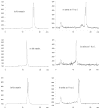Linker effects on biological properties of 111In-labeled DTPA conjugates of a cyclic RGDfK dimer
- PMID: 18069778
- PMCID: PMC2531146
- DOI: 10.1021/bc7002988
Linker effects on biological properties of 111In-labeled DTPA conjugates of a cyclic RGDfK dimer
Abstract
In this report, we present in vitro and in vivo evaluation of three 111 In-labeled DTPA conjugates of a cyclic RGDfK dimer: DTPA-Bn-SU016 (SU016 = E[c(RGDfK)] 2; DTPA-Bn = 2-( p-isothioureidobenzyl)diethylenetriaminepentaacetic acid), DTPA-Bn-E-SU016 ( E = glutamic acid) and DTPA-Bn-Cys-SU016 (Cys = cysteic acid). The integrin alpha vbeta 3 binding affinities of SU016, DTPA-Bn-SU016, DTPA-Bn-E-SU016, and DTPA-Bn-Cys-SU016 were determined to be 5.0 +/- 0.7 nM, 7.9 +/- 0.6 nM, 5.8 +/- 0.6 nM, and 6.9 +/- 0.9 nM, respectively, against 125 I-c(RGDyK) in binding to integrin alpha vbeta3, suggesting that E or Cys residue has little effect on the integrin alpha vbeta3 affinity of E[c(RGDfK)] 2. It was also found that the 111 In-labeling efficiency of DTPA-Bn-SU016 and DTPA-Bn-E-SU016 is 3-5 times better than that of DOTA analogues due to fast chelation kinetics and high-yield 111 In-labeling under mild conditions (e.g., room temperature). Biodistribution studies were performed using BALB/c nude mice bearing U87MG human glioma xenografts. 111 In-DTPA-Bn-SU016, 111 In-DTPA-Bn-E-SU016, and 111 In-DTPA-Bn-Cys-SU016 all displayed rapid blood clearance. Their tumor uptake was comparable between 0.5 and 4 h postinjection (p.i.) within experimental error. 111 In-DTPA-Bn-E-SU016 had a significantly lower ( p < 0.01) kidney uptake than 111 In-DTPA-Bn-SU016 and 111 In-DTPA-Bn-Cys-SU016. The liver uptake of 111 In-DTPA-Bn-SU016 was 1.69 +/- 0.18% ID/g at 24 h p.i., while the liver uptake values of 111 In-DTPA-Bn-E-SU016 and 111 In-DTPA-Bn-Cys-SU016 were 0.55 +/- 0.11% ID/g and 0.79 +/- 0.15% ID/g at 24 h p.i., respectively. Among the three 111 In radiotracers evaluated in this study, 111 In-DTPA-Bn-E-SU016 has the lowest liver and kidney uptake and the best tumor/liver and tumor/kidney ratios. Results from metabolism studies indicated that there is little metabolism (<10%) for three 111 In radiotracers at 1 h p.i. Imaging data showed that tumors can be clearly visualized at 4 h p.i. with good contrast in the tumor-bearing mice administered with 111 In-DTPA-Bn-E-SU016. It is concluded that using a glutamic acid linker can significantly improve excretion kinetics of the 111 In-labeled E[c(RGDfK)] 2 from liver and kidneys.
Figures







Similar articles
-
Impact of bifunctional chelators on biological properties of 111In-labeled cyclic peptide RGD dimers.Amino Acids. 2011 Nov;41(5):1059-70. doi: 10.1007/s00726-009-0439-0. Epub 2010 Jan 6. Amino Acids. 2011. PMID: 20052508
-
Improving tumor uptake and pharmacokinetics of (64)Cu-labeled cyclic RGD peptide dimers with Gly(3) and PEG(4) linkers.Bioconjug Chem. 2009 Apr;20(4):750-9. doi: 10.1021/bc800455p. Bioconjug Chem. 2009. PMID: 19320477 Free PMC article.
-
Improving tumor-targeting capability and pharmacokinetics of (99m)Tc-labeled cyclic RGD dimers with PEG(4) linkers.Mol Pharm. 2009 Jan-Feb;6(1):231-45. doi: 10.1021/mp800150r. Mol Pharm. 2009. PMID: 19067525 Free PMC article.
-
111In-Labeled 1,4,7,10-tetraazacyclododecane-1,4,7,10-tetracetic acid-Glu{PEG4-Glu[cyclo(Lys(Gly-Gly-Gly)-Arg-Gly-Asp-d-Phe)]-cyclo(Lys(Gly-Gly-Gly)-Arg-Gly-Asp-d-Phe)}-{PEG4-Glu[cyclo(Lys(Gly-Gly-Gly)-Arg-Gly-Asp-d-Phe)]-cyclo(Lys(Gly-Gly-Gly)-Arg-Gly-Asp-d-Phe)} (PEG4 = 15 amino-4,7,10,13-tetraoxapentadecanoic acid).2012 Feb 23 [updated 2012 Mar 22]. In: Molecular Imaging and Contrast Agent Database (MICAD) [Internet]. Bethesda (MD): National Center for Biotechnology Information (US); 2004–2013. 2012 Feb 23 [updated 2012 Mar 22]. In: Molecular Imaging and Contrast Agent Database (MICAD) [Internet]. Bethesda (MD): National Center for Biotechnology Information (US); 2004–2013. PMID: 22457888 Free Books & Documents. Review.
-
111In-Labeled 1,4,7,10-tetraazacyclododecane-1,4,7,10-tetracetic acid-Glu{PEG4-Glu[cyclo(Lys-Arg-Gly-Asp-d-Phe)]-cyclo(Lys-Arg-Gly-Asp-d-Phe)}-{PEG4-Glu[cyclo(Lys-Arg-Gly-Asp-d-Phe)]-cyclo(Lys-Arg-Gly-Asp-d-Phe)} (PEG4 = 15 amino-4,710,13-tetraoxapentadecanoic acid).2012 Feb 23 [updated 2012 Mar 22]. In: Molecular Imaging and Contrast Agent Database (MICAD) [Internet]. Bethesda (MD): National Center for Biotechnology Information (US); 2004–2013. 2012 Feb 23 [updated 2012 Mar 22]. In: Molecular Imaging and Contrast Agent Database (MICAD) [Internet]. Bethesda (MD): National Center for Biotechnology Information (US); 2004–2013. PMID: 22457887 Free Books & Documents. Review.
Cited by
-
Development of a Novel, Easy-to-Prepare, and Potentially Valuable Peptide Coupling Technology Utilizing Amide Acid as a Linker.Pharmaceuticals (Basel). 2024 Jul 24;17(8):981. doi: 10.3390/ph17080981. Pharmaceuticals (Basel). 2024. PMID: 39204086 Free PMC article.
-
Triazine-based tool box for developing peptidic PET imaging probes: syntheses, microfluidic radiolabeling, and structure-activity evaluation.Bioconjug Chem. 2014 Apr 16;25(4):761-72. doi: 10.1021/bc500034n. Epub 2014 Apr 4. Bioconjug Chem. 2014. PMID: 24661266 Free PMC article.
-
Multivalent bifunctional chelator scaffolds for gallium-68 based positron emission tomography imaging probe design: signal amplification via multivalency.Bioconjug Chem. 2011 Aug 17;22(8):1650-62. doi: 10.1021/bc200227d. Epub 2011 Jul 26. Bioconjug Chem. 2011. PMID: 21740059 Free PMC article.
-
Integrin αvβ3-targeted IRDye 800CW near-infrared imaging of glioblastoma.Clin Cancer Res. 2012 Oct 15;18(20):5731-40. doi: 10.1158/1078-0432.CCR-12-0374. Epub 2012 Aug 22. Clin Cancer Res. 2012. PMID: 22914772 Free PMC article.
-
Evaluation of 111In-labeled cyclic RGD peptides: tetrameric not tetravalent.Bioconjug Chem. 2010 May 19;21(5):969-78. doi: 10.1021/bc900555q. Bioconjug Chem. 2010. PMID: 20387808 Free PMC article.
References
-
- Folkman J. Fundamental concepts of the angiogenic process. Curr Mol Med. 2003;3:643–651. - PubMed
-
- Howe A, Aplin AE, Alahari SK, Juliano RL. Integrin signaling and cell growth control. Curr Opin Cell Biol. 1998;10:220–231. - PubMed
-
- Zitzmann S, Ehemann V, Schwab M. Arginine-Glycine-Aspartic acid (RGD)-peptide binds to both tumor and tumor endothelial cells in vivo. Cancer Res. 2002;62:5139–5143. - PubMed
Publication types
MeSH terms
Substances
Grants and funding
LinkOut - more resources
Full Text Sources

